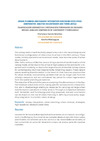Identificador persistente para citar o vincular este elemento:
https://accedacris.ulpgc.es/handle/10553/110189
| DC Field | Value | Language |
|---|---|---|
| dc.contributor.author | García Sánchez, Francisco | en_US |
| dc.contributor.author | Ribalaygua, Cecilia | en_US |
| dc.date.accessioned | 2021-07-05T09:44:29Z | - |
| dc.date.available | 2021-07-05T09:44:29Z | - |
| dc.date.issued | 2021 | en_US |
| dc.identifier.isbn | 978-84-9042-400-1 | en_US |
| dc.identifier.uri | https://accedacris.ulpgc.es/handle/10553/110189 | - |
| dc.description.abstract | The railway station has historically played a key role in the morphological and functional configuration of cities since its arrival in the 19th century. These nodes, initially planned to serve sectoral needs, have become poles of urban development. After half a century of decline, we are living a period of transformation of the railway mode, either due to the arrival of high-speed, to the policies for a required multi-modality, or due to the large amount of obsolete railway spaces for contemporary technical requirements remaining vacant. These vacant spaces awaiting transformation in the heart of cities become opportunities for urban renewal, incorporating variables that are no longer just from the railway’s viewpoint, but are considered key pieces for urban regeneration from the spatial planning perspective. The objective of the article focuses on analyzing this phenomenon in the Spanish medium-sized cities which, having specific socioeconomic characteristics, are in disadvantage relating to resources for carrying out large urban transformation operations in these sectors. Through a comparison between both Santander and Torrelavega planning proposals, relevant conclusions can be drawn on the role of Urban Planning in defining a local policy regarding integration in a holistic urban strategy. | en_US |
| dc.description.abstract | La estación ferroviaria desempeña históricamente un rol clave en la configuración morfológica y funcional de las ciudades desde el siglo XIX. Estos nodos, planificados inicialmente para dar servicio a las necesidades sectoriales, se han convertido en polos del desarrollo urbano de buena parte de nuestras ciudades. Después de medio siglo de declive de los entornos asociados al tren, vivimos un momento de transformación del modo ferroviario, bien por la llegada de la alta velocidad, bien por las políticas de unificación y concentración para la requerida multi-modalidad, o bien por la gran cantidad de suelo ferroviario obsoleto para los requisitos técnicos contemporáneos que queda vacante. Estos espacios vacantes a la espera de transformación en el corazón de las ciudades se convierten en oportunidades de transformación urbana, incorporando variables que han dejado de ser sólo ferroviarias, y son consideradas en el planeamiento urbanístico local como piezas clave para la regeneración urbana. El objetivo del artículo se centra en analizar este fenómeno en las ciudades medias españolas que por sus características socioeconómicas se ven desfavorecidas en la recepción de recursos para realizar grandes operaciones de transformación urbana de estos entornos. Mediante un comparativa entre las propuestas de Santander y Torrelavega podemos extraer conclusiones extrapolables sobre la función del Planeamiento en la definición de una política local respecto a la integración de los espacios ferroviarios en la estrategia urbana. | en_US |
| dc.language | eng | en_US |
| dc.publisher | Servicio de Publicaciones y Difusión Científica de la Universidad de Las Palmas de Gran Canaria | en_US |
| dc.source | La reconfiguración capitalista de los espacios urbanos: transformaciones y desigualdades / Juan Manuel Parreño Castellano y Claudio Jesús Moreno Medina (Coords.), p. 477-491 | en_US |
| dc.subject | 540401 Geografía urbana | en_US |
| dc.subject | 620103 Urbanismo | en_US |
| dc.subject.other | Railway integration | en_US |
| dc.subject.other | Urban planning | en_US |
| dc.subject.other | Urban renewal | en_US |
| dc.subject.other | Strategies | en_US |
| dc.subject.other | High-speed rail | en_US |
| dc.subject.other | Medium-sized cities | en_US |
| dc.subject.other | Integración ferroviaria | en_US |
| dc.subject.other | Planeamiento urbanístico | en_US |
| dc.subject.other | Regeneración urbana | en_US |
| dc.subject.other | Estrategias | en_US |
| dc.subject.other | Alta velocidad ferroviaria | en_US |
| dc.subject.other | Ciudades medias | en_US |
| dc.title | Urban planning and railway integration in medium-sized cities: comparative analysis in Santander and Torrelavega | en_US |
| dc.title.alternative | Planificación urbanística e integración ferroviaria en ciudades medias: análisis comparado de Santander y Torrelavega | en_US |
| dc.type | info:eu-repo/semantics/bookPart | en_US |
| dc.type | BookPart | en_US |
| dc.relation.conference | XV Coloquio de Geografía Urbana | - |
| dc.description.lastpage | 491 | en_US |
| dc.description.firstpage | 477 | en_US |
| dc.investigacion | Artes y Humanidades | en_US |
| dc.type2 | Capítulo de libro | en_US |
| dc.utils.revision | Sí | en_US |
| dc.identifier.ulpgc | Sí | en_US |
| dc.identifier.ulpgc | Sí | en_US |
| dc.identifier.ulpgc | Sí | en_US |
| dc.identifier.ulpgc | Sí | en_US |
| dc.contributor.buulpgc | BU-HUM | en_US |
| dc.contributor.buulpgc | BU-HUM | en_US |
| dc.contributor.buulpgc | BU-HUM | en_US |
| dc.contributor.buulpgc | BU-HUM | en_US |
| item.fulltext | Con texto completo | - |
| item.grantfulltext | open | - |
| crisitem.event.eventsstartdate | 19-10-2020 | - |
| crisitem.event.eventsenddate | 20-10-2020 | - |
| Appears in Collections: | Capítulo de libro | |
Page view(s)
98
checked on Feb 17, 2024
Download(s)
147
checked on Feb 17, 2024
Google ScholarTM
Check
Altmetric
Share
Export metadata
Items in accedaCRIS are protected by copyright, with all rights reserved, unless otherwise indicated.
